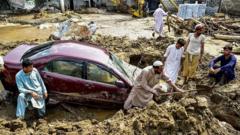Recent reports indicate that torrential rains have wreaked havoc in northern Pakistan, especially in the Buner district, where local authorities cite at least 209 missing persons, feared to increase as rescue attempts continue. Jehangir Khan, the Deputy Commissioner’s spokesman, revealed that rescue teams have buried eight unidentified victims whose relatives could not be found due to disrupted communication and severely damaged roads.
Asfandyar Khattak, leading the provincial disaster management authority, pointed out that other districts like Shangla are also witnessing a grave situation with dozens of citizens unaccounted for. The devastating effects of the monsoon season, especially the persistent rains that have battered the region, have led to disastrous flash floods—recording over 650 fatalities this season alone.
The heavy rains, anticipated to persist until August 21, have caused significant destruction across multiple areas, declaring many as disaster zones. While climate change is exacerbating the frequency and intensity of such weather events, glaciologists warn that melting glaciers contribute to the resulting landslides, potentially blocking water flow and increasing the flood risks.
Previous reports have detailed the loss of life caused by similar weather phenomena across the border in Indian-administered Kashmir, emphasizing the regional impact of these climate-induced disasters. As Pakistan continues to navigate the fallout from its devastating monsoon, the affected communities are in dire need of support and assistance during this unprecedented crisis.
Asfandyar Khattak, leading the provincial disaster management authority, pointed out that other districts like Shangla are also witnessing a grave situation with dozens of citizens unaccounted for. The devastating effects of the monsoon season, especially the persistent rains that have battered the region, have led to disastrous flash floods—recording over 650 fatalities this season alone.
The heavy rains, anticipated to persist until August 21, have caused significant destruction across multiple areas, declaring many as disaster zones. While climate change is exacerbating the frequency and intensity of such weather events, glaciologists warn that melting glaciers contribute to the resulting landslides, potentially blocking water flow and increasing the flood risks.
Previous reports have detailed the loss of life caused by similar weather phenomena across the border in Indian-administered Kashmir, emphasizing the regional impact of these climate-induced disasters. As Pakistan continues to navigate the fallout from its devastating monsoon, the affected communities are in dire need of support and assistance during this unprecedented crisis.



















